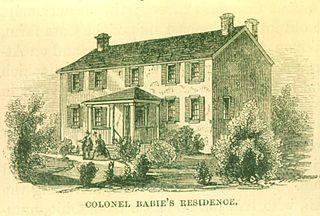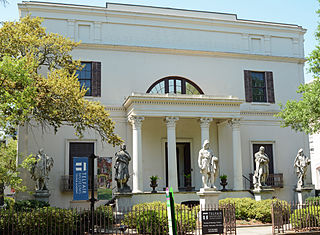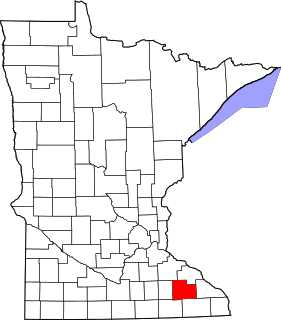
Dodge County is a county located in the central portion of the U.S. state of Georgia. As of 2010, the population was 21,796. The county seat is Eastman. Dodge County lies in the Historic South and Black Belt region of Georgia, an area that was devoted to cotton production in the antebellum years. It has significant historic buildings and plantations, has a substantial African-American population, and shows cultural aspects of the South.

Eastman is a city in Dodge County, Georgia, United States. The population was 4,962 at the 2010 census. Named after one of the founders who contributed a site and paid for the county courthouse, the city was established in 1871, and is the county seat of Dodge County.

The George Eastman Museum, also referred to as George Eastman House, International Museum of Photography and Film, the world's oldest museum dedicated to photography and one of the world's oldest film archives, opened to the public in 1949 in Rochester, New York.

The Georgia Trust for Historic Preservation is the United States' largest statewide, nonprofit preservation organization with more than 8,000 members. Founded in 1973 by Mary Gregory Jewett and others, the Trust is committed to preserving and enhancing Georgia's communities and their diverse historic resources for the education and enjoyment of all.

The Clinton House is an 18th-century Georgian stone building in the city of Poughkeepsie, Dutchess County, New York, United States. It is a New York State Historic Site and has been listed in the National Register of Historic Places as a historic place of local significance since 1982. The house was named for George Clinton, who served as the first Governor of New York and fourth Vice-President of the United States. He was believed to have lived there after the American Revolutionary War, but it is now known that it was never his residence.

Long Island, also known as Long Island of the Holston, is an island in the Holston River at Kingsport in East Tennessee. Important in regional history since pre-colonial times, the island is listed on the National Register of Historic Places and is designated as a U.S. National Historic Landmark District.

The François Bâby House is a historic residence located in Windsor, Ontario, Canada which was owned by the prominent local politician François Baby. The house is a two-storey, Georgian style, red brick house once known as La Ferme locally, and was a French-Canadian ribbon farm which was a long narrow tract fronting endwise on the Detroit River. The home itself has historical ties to the War of 1812 where it was used as a headquarters by both the American and British forces.
Edward Columbus Hosford, also known as Edward C. Hosford and E. C. Hosford, was an American architect noted for the courthouses and other buildings that he designed in Florida, Georgia and Texas.

The Dodge County Courthouse is a historic courthouse building located in Eastman, Georgia. Built in 1908, it was designed by Eastman-born American architect Edward Columbus Hosford, who is noted for the courthouses and other buildings that he designed in Florida, Georgia and Texas. The builder was M.L. Lewman & Company. This was the very first courthouse Hosford had ever designed. His commission was controversial because his father, Charlie Columbus Hosford, was a member of the building committee appointed by the county commissioners. Since Edward C. Hosford then lived in Atlanta, it was rumored that he was going to farm the project out to the more experienced architect who had been bypassed in order to give him the commission, but he moved back to Eastman and did all the work himself.

The Telfair Academy is a historic mansion at 121 Barnard Street in Savannah, Georgia. It was designed by William Jay and built in 1818, and is one of a small number of Jay's surviving works. It is one of three sites owned by Telfair Museums. Originally a family townhouse belonging to the Telfair family, it became a free art museum in 1886, and thus one of the first 10 art museums in America, and the oldest public art museum in the South. Its first director, elected in 1883, was artist Carl Ludwig Brandt, who spent winters in Savannah. It was declared a National Historic Landmark in 1976.

Peabody School, also known as Peabody High School, is an historic school building located on Herman Avenue in Eastman, Georgia. Built in 1938, it was designed by Eastman-born American architect Edward Columbus Hosford, who is noted for the courthouses and other buildings that he designed in Florida, Georgia and Texas. The brick building's design includes elements of the Colonial Revival style. The segregated school educated the African-American high school students of Eastman and most other parts of Dodge County. In 1950, the school became an elementary school serving grades 1-8 after a new high school opened. It was closed in 1970 and its students were integrated into Dodge County High School and other formerly all-white public schools in Dodge County.

The William Paca House is an 18th-century Georgian mansion in Annapolis, Maryland, United States. William Paca was a signatory of the Declaration of Independence and a three-term Governor of Maryland. The house was built between 1763 and 1765 and its architecture was largely designed by Paca himself. The 2-acre (8,100 m2) walled garden, which includes a two-story summer house, has been restored to its original state.

The Pitt Clarke House is a historic house located in Norton, Massachusetts.

This is a list of the National Register of Historic Places listings in Olmsted County, Minnesota. It is intended to be a complete list of the properties and districts on the National Register of Historic Places in Olmsted County, Minnesota, United States. The locations of National Register properties and districts for which the latitude and longitude coordinates are included below, may be seen in an online map.
This is a list of properties and districts in Bibb County, Georgia that are listed on the National Register of Historic Places (NRHP).

The Dodge Mansion, also known as Turner-Dodge House, is a historic house in Lansing, Michigan that was built in 1855. It was listed on the National Register of Historic Places (NRHP) in 1972 as Dodge Mansion.

Orphans Cemetery is a four-acre cemetery located at the southwest corner of Orphans Cemetery Road and Jim Harp Road between US 341 and US 23 near Eastman, Georgia. The area was originally known as Orphans in honor of Albert Genavie Williamson, a Dodge County entrepreneur, and his five younger orphaned brothers who moved there in 1873-74 from North Carolina.

The William K. Eastman House, also known as the Eastman-Lord House, is a historic house museum at 100 Main Street in Conway, New Hampshire. Built in 1818, it was the home of William K. Eastman, a prominent local businessman, politician, and civic leader until his death in 1879. Now home to the Conway Historical Society, it was listed on the National Register of Historic Places in 2001.

The Old County Road South Historic District is a rural historic district encompassing a well-preserved collection of 18th and early 19th-century rural farm properties in Francestown, New Hampshire. It includes nine houses, whose construction dates from 1774 to 1806, and the only two extant 18th-century saltbox-style houses in the town. There is also a Cape-style house built using the relatively rare vertical-plank method of framing, and there are several surviving 19th-century barns. The district covers 500 acres (200 ha) along all or part of Old County Road South, Pratt (Clark) Road, and Birdsall Road. The district was listed on the National Register of Historic Places in 1980.
Charles Blaney Cluskey was an American architect active from the 1830s to the start of the Civil War, and therefore he is recognized as an antebellum architect. He is reputed to be the initiator of the Greek Revival–style in the south, and his commissions, both public and private, can still be seen in Augusta, Milledgeville and Savannah, Georgia.


















